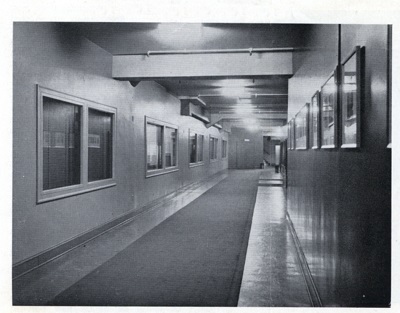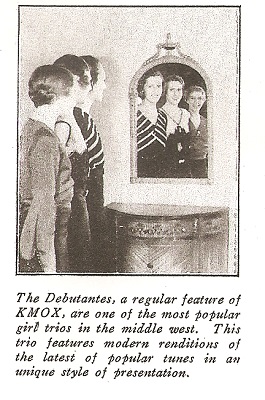Radio Articles
WIL’s Night Watchman Was Everywhere
By Nancy Fraser
Borrowing a dainty little flashlight as the 1932 version of Diogenes’ lantern, I foregathered with the “Old Night Watchman” of WIL on Sunday night to help him augment the revels of St. Louis night life upon his rounds to assure radio listeners that “All is well.”
Thrilled to death I was for the idea of being assistant “watch lady” was unique enough in itself without having the fun of tearing about the city in a battery and amplifier-ladened Ford with a red lantern swinging in its wake. It was with a feeling of romantic glow of adventure that I met Billy Lang, the Old Night Watchman and Little Willie Keller, the remote control man at the Ambassador Theater at 8 o’clock to begin the thirty-five mile round. I wasn’t disappointed.
There in the screening room were the twenty “Gloom Chasers” led by a collarless Al Roth, Ambassador music director. They were working hard on the torrid night to send sweet strains of music over the air. As the last noted were wafted, up jumped Little Willie and disjointed the microphone and started putting wires and tubes and boxes together; the Night Watchman helping him. Being somewhat of a novice at the serious business, I was so confused that I all but got coiled up with the cords and put into the panel box. They discovered me in time though and we were out of the street and crammed into the “waiting” Ford to begin our land “hop” down to Sauter’s Park.
Streets flew by, headlights danced and the soft air from the Mississippi rose to greet us as we accomplished that leg of the journey in less than thirty minutes.
Little Willie dashed into the pavilion ahead of us and by the time we had threaded our way over the gaily illuminated floor, he had set up the microphone, twisted a few knobs on the amplifier and was ringing the control room in WIL saying “OK.” Then the Night Watchman climbed on the stage and with his “Heigh-Ho, everybody” began announcing the numbers of Dewey Jackson’s Harlem hot rhythm band.
 I couldn’t help but reflect what a lot of pleasure such an open air place gave young people who were swaying and whirling around in floor in an inspired manner. It was cool, gaily lighted and the music impelling. I had a severe case of the “jitters” when Billy Langinvited me up to the microphone to announce a few of the numbers and couldn’t help envying him his easy manner and infectious smile as he greeted his friends both on the floor and over the air. There is a stir of anticipation when the Old Night Watchman enters each place and it is easy to see what an addition he is to the spirit of revelry.
I couldn’t help but reflect what a lot of pleasure such an open air place gave young people who were swaying and whirling around in floor in an inspired manner. It was cool, gaily lighted and the music impelling. I had a severe case of the “jitters” when Billy Langinvited me up to the microphone to announce a few of the numbers and couldn’t help envying him his easy manner and infectious smile as he greeted his friends both on the floor and over the air. There is a stir of anticipation when the Old Night Watchman enters each place and it is easy to see what an addition he is to the spirit of revelry.
The half-hour raced by and we were going through the same performance of taking down the equipment and loading it into the car although I had by then learned enough to keep out of the way and to even carry the tiara-like mike with the significant call letters WIL across the top.
Dodging returning weekenders in a nineteen-mile circle of the country, we found ourselves on the Olive Street Road at Diane’s, the new dine and dance palace. We received a royal welcome there from everybody from the doorman up to Miss Diane herself.
Little Willie had the accoutrements strung up in the mere “twinkling of an eye” while Miss Diane, who is a tall, stately and gracious blonde person, proudly showed me the softly lighted café and introduced me to the delightfully silly entertainers including Al Rusell, the dancer, Larry Green, eccentric second Al Jolson and Ray DeVinney, drummer dance band leader.
The smart looking crowd joined in the dancing and greeting of the Night Watchman and a lot of impromptu specialties went over the air. The music was good, the crowd lightly gay and the hostess charming – so it was small wonder that the Night Watchman and humble assistant sneaked in a syncopated three turns about the floor before tearing ourselves away to join Bill Bailey at the Canton Tea Garden. And it was a thrill to dance with six-feet-four-and-a-quarter charming Billy Lang – Night Watchman or otherwise.
Another Ford flight and we were back in the center of busy St. Louis listening to Bill Bailey’s eccentric xylophone playing. There I helped Billy in “heighhoing,” getting the numbers all mixed up but thoroughly enjoying myself. It was just twelve when we bade the audience a regretful goodnight and little Willie packed up for the last time. Fleet Smith joined us and with our official duties over, we went back to Diane’s to catch the last floor show.
With tapping steps and well sung popular tunes still resounding in our ears, we left there in time to join the two o’clock bathing party at Sauter’s Park and it was near the dawn when we finally disbanded.
Weary I was but enchanted with the amusing possibilities of nightwatching with infectiously charming Billy Lang leading the lanterned way who uses the microphone instead of the stick to announce “All is Well.”
(Originally published in Radio and Entertainment 7/30/1932).
 The floors of radio station KMOX are all covered with serviceable floor coverings: rubber tile, asphalt tile, rubber and linoleum. The KMOX Playhouse has carpeting in the area used for the seating of audiences and the center portion of the main corridor is carpeted. Mr. L.C. Burrows, Maintenance Engineer for KMOX, has a crew of five men under the supervision of Mr. J.L. Scherder who takes excellent care of the floor services.
The floors of radio station KMOX are all covered with serviceable floor coverings: rubber tile, asphalt tile, rubber and linoleum. The KMOX Playhouse has carpeting in the area used for the seating of audiences and the center portion of the main corridor is carpeted. Mr. L.C. Burrows, Maintenance Engineer for KMOX, has a crew of five men under the supervision of Mr. J.L. Scherder who takes excellent care of the floor services.
 A new trio made its appearance to the radio audience of KMOX, The Voice of St. Louis, last Sunday at 10:15 a.m. The trio to which we refer is “The Debutantes” whose vocal harmonies attracted so much attention on Sunday’s broadcast that the telephones of KMOX were kept busy for hours answering calls from the inquiring audience who wanted to know just who these three girls really were.
A new trio made its appearance to the radio audience of KMOX, The Voice of St. Louis, last Sunday at 10:15 a.m. The trio to which we refer is “The Debutantes” whose vocal harmonies attracted so much attention on Sunday’s broadcast that the telephones of KMOX were kept busy for hours answering calls from the inquiring audience who wanted to know just who these three girls really were.